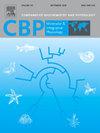捕获方法和处理时间对底栖板鳃亚目生理应激反应的影响。
IF 2.2
3区 生物学
Q4 BIOCHEMISTRY & MOLECULAR BIOLOGY
Comparative Biochemistry and Physiology A-Molecular & Integrative Physiology
Pub Date : 2025-10-04
DOI:10.1016/j.cbpa.2025.111940
引用次数: 0
摘要
海洋动物越来越多地受到人为干扰,这些干扰破坏了它们的行为并引起生理应激。在脊椎动物中,压力源如人为干扰会增加糖皮质激素的分泌。尽管鲨鱼是最受威胁的海洋动物之一,但人们对它们的糖皮质激素生理知之甚少。研究了不同的捕获方法(手捕和竿捕)对杰克森港鲨生理应激反应的影响。我们在捕获后立即测量乳酸和葡萄糖水平,并在现场使用即时护理(POC)设备测量60分钟。然后,我们验证了我们的葡萄糖和乳酸测量使用传统的实验室分析。此外,我们测量了与糖皮质激素生理相关的两种激素(促肾上腺皮质激素和皮质酮)。即时护理设备可以可靠地测量杰克逊港鲨鱼的乳酸水平,但不能测量葡萄糖水平。乳酸和皮质酮水平在捕获后的60分钟内升高。用手捕获的鲨鱼皮质酮水平较高,但乳酸水平与用鱼竿和卷轴捕获的鲨鱼相似。虽然在捕捉鲨鱼时使用鱼钩会导致身体受伤,但我们的研究结果挑战了用手捕捉鲨鱼比用沉重的钓竿和卷轴捕捉鲨鱼压力小的假设。我们的研究强调了POC设备在测量鲨鱼生理应激反应相关指标方面的潜在用途,并增加了我们对捕获方法和人为干扰对鲨鱼应激反应的影响的理解。本文章由计算机程序翻译,如有差异,请以英文原文为准。

Effects of capture method and handling time on the physiological stress responses of a benthic elasmobranch
Marine animals are increasingly exposed to anthropogenic disturbances that disrupt their behaviour and induce physiological stress. In vertebrates, stressors such as anthropogenic disturbances increase the production of glucocorticoid hormones. Although sharks are one of the most threatened groups of marine animals, relatively little is known about their glucocorticoid physiology. We investigated how different capture methods (hand capture and rod and reel) affected physiological stress responses of Port Jackson sharks (Heterondontus portusjacksoni). We measured lactate and glucose levels immediately following capture and over 60-min in the field using point-of-care (POC) devices. We then validated our glucose and lactate measurements using traditional laboratory assays. Additionally, we measured two hormones associated with glucocorticoid physiology (adrenocorticotropic hormone and corticosterone). Point-of-care devices could reliably measure lactate levels of Port Jackson sharks, but not glucose levels. Lactate and corticosterone levels increased over the 60-min holding period post-capture. Sharks captured by hand had higher corticosterone levels but similar lactate levels to sharks caught by rod and reel. While the use of hooks can lead to physical injuries when capturing sharks, our findings challenge the assumption that capturing sharks by hand is less stressful than rod and reel with heavy tackle. Our study highlights the potential use of POC devices to measure metrics associated with physiological stress responses in sharks and increases our understanding of the effects of capture methods and anthropogenic disturbances on shark stress responses.
求助全文
通过发布文献求助,成功后即可免费获取论文全文。
去求助
来源期刊
CiteScore
5.00
自引率
4.30%
发文量
155
审稿时长
3 months
期刊介绍:
Part A: Molecular & Integrative Physiology of Comparative Biochemistry and Physiology. This journal covers molecular, cellular, integrative, and ecological physiology. Topics include bioenergetics, circulation, development, excretion, ion regulation, endocrinology, neurobiology, nutrition, respiration, and thermal biology. Study on regulatory mechanisms at any level of organization such as signal transduction and cellular interaction and control of behavior are also published.

 求助内容:
求助内容: 应助结果提醒方式:
应助结果提醒方式:


